高考英语阅读理解中推理题的解题技巧
- 格式:ppt
- 大小:730.50 KB
- 文档页数:18
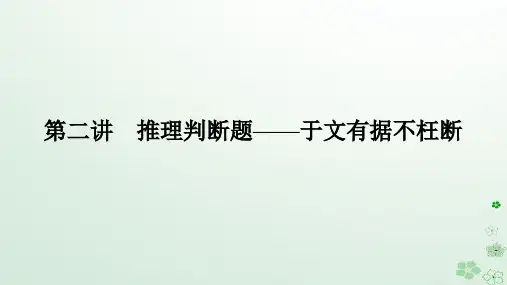
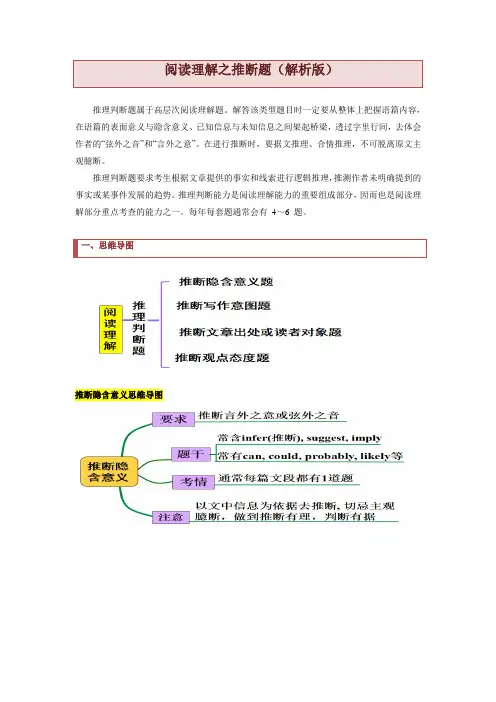
阅读理解之推断题(解析版)推理判断题属于高层次阅读理解题。
解答该类型题目时一定要从整体上把握语篇内容,在语篇的表面意义与隐含意义、已知信息与未知信息之间架起桥梁,透过字里行间,去体会作者的“弦外之音”和“言外之意”。
在进行推断时,要据文推理、合情推理,不可脱离原文主观臆断。
推理判断题要求考生根据文章提供的事实和线索进行逻辑推理,推测作者未明确提到的事实或某事件发展的趋势。
推理判断能力是阅读理解能力的重要组成部分,因而也是阅读理解部分重点考查的能力之一。
每年每套题通常会有4~6 题。
一、思维导图推断隐含意义思维导图二、方法点拨(一)推理判断题题干常用词一般来说,推理判断题题干中主要包括下面的词语:know about, learn from, infer, imply, suggest, conclude, purpose, attitude, probably, most likely等。
(二)推理判断题正确选项特征推理判断题中的正确选项是依据文章的事实或证据推断出的符合逻辑的结论或观点,正确选项一般具有以下特征:1.“立足原文,只推一步”,即根据原文内容,一步即可推得。
2.选项中一般不可以出现绝对概念。
如only, never, all, absolutely等,正确答案的表述一般有一点模糊,会用一些相对能够留有一些余地的词汇,如often, usually, sometimes, some, may, might, can, could, possibly, probably等。
(三)推理判断题干扰选项特征1.曲解文意:即推测意义与文章表层意义有区别。
推理判断题中有些选项来自文章中的某一句或某几句话,命题者可能会利用里面的词设计出干扰项,看似表达文章的意思,其实是借题发挥,是对原文意思的曲解。
2.张冠李戴:即把文章中作者的观点与其他人的观点混淆在一起。
题干问的是作者的观点,选项中出现的却是其他人的观点;题干问的是其他人的观点,选项中却出现了作者的观点。
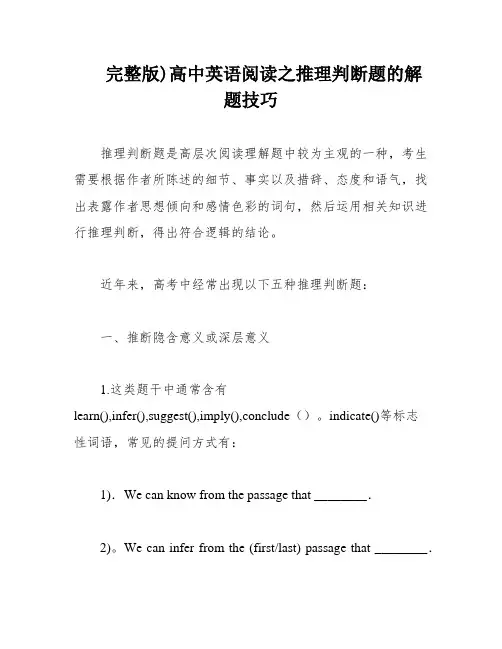
完整版)高中英语阅读之推理判断题的解题技巧推理判断题是高层次阅读理解题中较为主观的一种,考生需要根据作者所陈述的细节、事实以及措辞、态度和语气,找出表露作者思想倾向和感情色彩的词句,然后运用相关知识进行推理判断,得出符合逻辑的结论。
近年来,高考中经常出现以下五种推理判断题:一、推断隐含意义或深层意义1.这类题干中通常含有learn(),infer(),suggest(),imply(),conclude()。
indicate()等标志性词语,常见的提问方式有:1).We can know from the passage that ________.2)。
We can infer from the (first/last) passage that ________.3).___ ______.4).It ___ ________.5).The underlined sentence indicates that ________2.解题技巧①针对细节推断:在原文中找到相关的信息源,对具体内容进行分析,推理判断得出结论。
例如,原文中提到“你是否曾经听到过从墙壁里传来的奇怪声音?它听起来像是一个时钟吗?如果是的话,那可能是由一个甲虫制造的。
很久以前,人们认为这个滴答声意味着有人即将死去。
因此,这种甲虫被称为“死亡守望者甲虫”。
从文中可以推断出,这种甲虫的声音让人感到________。
A.高兴B.惊讶C.恐惧D.兴奋需要填的是C,因为文中明确提到人们曾经认为这种声音意味着有人即将死去,因此可以推断出这种声音让人感到恐惧。
Why ___ any good news。
All I read about is murder。
bribery。
and death。
Frankly。
I’m sick of all the bad news.The author ___。
___ with the constant barrage of bad news。
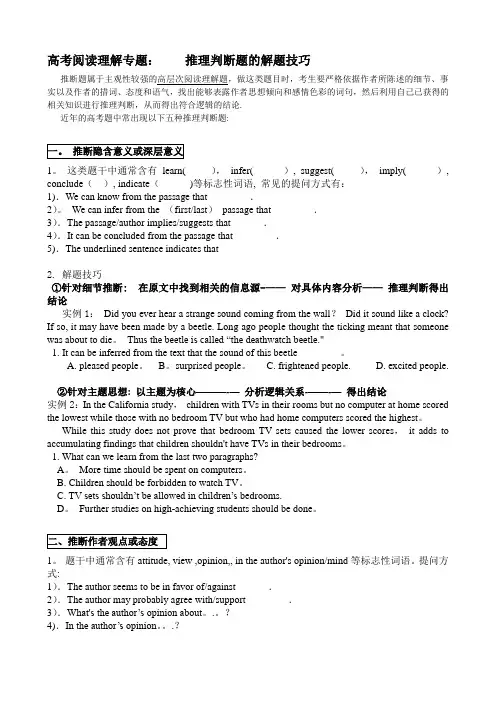
高考阅读理解专题:推理判断题的解题技巧推断题属于主观性较强的高层次阅读理解题,做这类题目时,考生要严格依据作者所陈述的细节、事实以及作者的措词、态度和语气,找出能够表露作者思想倾向和感情色彩的词句,然后利用自己已获得的相关知识进行推理判断,从而得出符合逻辑的结论.近年的高考题中常出现以下五种推理判断题:1。
这类题干中通常含有learn( ),infer( ), suggest( ),imply( ), conclude(), indicate()等标志性词语, 常见的提问方式有:1).We can know from the passage that ________.2)。
We can infer from the (first/last)passage that ________.3).The passage/author implies/suggests that ______.4).It can be concluded from the passage that ________.5).The underlined sentence indicates that ________2. 解题技巧①针对细节推断: 在原文中找到相关的信息源-——对具体内容分析——推理判断得出结论实例1:Did you ever hear a strange sound coming from the wall?Did it sound like a clock? If so, it may have been made by a beetle. Long ago people thought the ticking meant that someone was about to die。
Thus the beetle is called “the deathwatch beetle."1. It can be inferred from the text that the sound of this beetle ________。
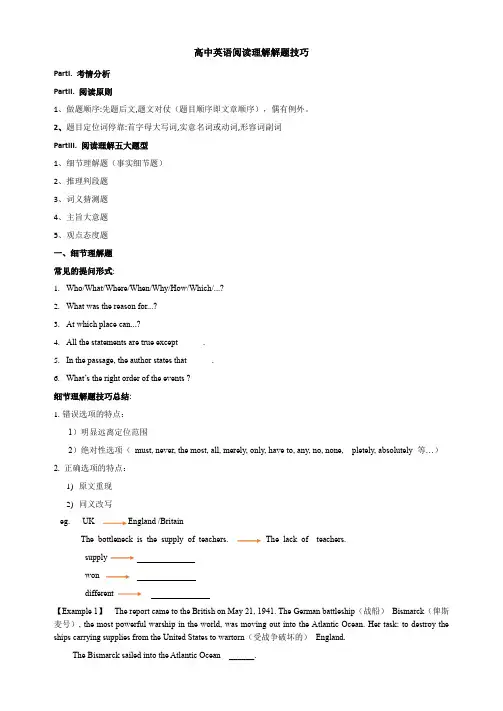
高中英语阅读理解解题技巧PartI. 考情分析PartII. 阅读原则1、做题顺序:先题后文,题文对仗(题目顺序即文章顺序),偶有例外。
2、题目定位词停靠:首字母大写词,实意名词或动词,形容词副词PartIII. 阅读理解五大题型1、细节理解题(事实细节题)2、推理判段题3、词义猜测题4、主旨大意题5、观点态度题一、细节理解题常见的提问形式:1.Who/What/Where/When/Why/How/Which/...?2.What was the reason for...?3.At which place can...?4.All the statements are true except.5.In the passage, the author states that.6.What’s the right order of the events ?细节理解题技巧总结:1.错误选项的特点:1)明显远离定位范围2)绝对性选项(must, never, the most, all, merely, only, have to, any, no, none, pletely, absolutely 等…)2. 正确选项的特点:1)原文重现2)同义改写eg. UK England /BritainThe bottleneck is the supply of teachers. The lack of teachers.supplywondifferent【Example 1】The report came to the British on May 21, 1941. The German battleship(战船)Bismarck(俾斯麦号), the most powerful warship in the world, was moving out into the Atlantic Ocean. Her task: to destroy the ships carrying supplies from the United States to wartorn(受战争破坏的)England.The Bismarck sailed into the Atlantic Ocean ______.A. to sink the Hood(胡德号战舰)B. to gain control of FranceC. to cut off American supplies to BritainD. to stop British warships reaching Germany【Example 2】The report came to the British on May 21, 1941. The German battleship(战船)Bismarck(俾斯麦号), the most powerful warship in the world, was moving out into the Atlantic Ocean. Her task: to destroy the ships carrying supplies from the United States to wartorn(受战争破坏的)England.The British had feared such a task. No warships(战船)they had could match the Bismark(俾斯麦号)in speed or in firepower(火力). The Bismarck had eight 15inch guns(火炮)and 81 smaller guns. She could move at 30 nautical miles (海里) an hour. She was believed to be unsinkable(不沉的).Many people believed that the Bismarck was the most strongest one because she ______.A. was fast and powerfulB. had more men on boardC. was under Luetjens’ mandD. had bigger guns than other ships牛刀小试:【EX. 1】However, the British had to sink her. They force their best battleship Hood(胡德号战舰)to hunt down the Bismarck(俾斯麦号). On May 24, the Hood found the Bismarck.It was a meeting(会面)that the German mander(指挥官)did not want to see. His orders were to destroy the British ships that were carrying supplies, but to stay away from a fight with British warships.The battle didn’t last long. The Bismarck’s first torpedo (鱼雷) hit the Hood, which went down taking all but three of her 1, 419 men with her.We learn from the text that on 24 May ______.A. the British won the battle against the BismarckB. the Bismarck won the battle against the BritishC. the British gunfire damaged the Bismarck seriouslyD. the Bismarck succeeded in keeping away from the British【EX. 2】But in the fight, the Bismarck was slightly damaged . Her mander decided to run for repairs to France, which had at that time been taken by the Germans. The British force followed her. However, because of the Bismarck’s speed and the heavy fog, they lost sight of her.Her mander tried to sail(航行)to France in order to ______.A. have the ship repairedB. join the other GermansC. get help from the FrenchD. get away from the British二、推理判断题常见提问方式1.The passage implies (暗示) that_______.2.We can conclude (得出结论) from the passage that_____.3.Which of the following can be inferred (推论)?4.What is the tone (语气) of the author ?5.What is the purpose (目的) of this passage?6.The passage is intended to (倾向于) _____.7.Where would this passage most probably appear(出现)?8.The next paragraph would most probably deal with_______.9.At the end of this passage, the writer might continue to write _______.技巧点拨:1.推断隐含意义【Example 1】A buildityourself solar still(自制太阳能蒸馏器)is one of the best ways to obtain drinking water in areas where the liquid is not readily available…..The only ponents(成分)required, though, are a 5' ×5' sheet of clear(透明的)or slightly milky(略带乳白色的)plastic, six feet of plastic tube(试管), and a container(容器)—perhaps just a drinking cup —to catch the water. These pieces can be folded(折叠)into a neat little pack and fastened(系)on your belt(腰带).1.What do we know about the solar still (蒸馏器)from the first paragraph? ()A. It’s delicate(精致的).B. It’s expensive.C. It’s plex.D. It’s portable(便携的).推断隐含意义题技巧总结:①Scanning,找到相关信息点②Study reading,不但理解表层,而且要由表及里、由浅入深地分析③推理,以文中提供的信息为依据,结合常识,作出符合逻辑的推断2.推断写作目的【Example 1】It’s an amazing acplishment(成就)and one we cannot achieve without generous support from individuals, corporations(企业), and other social organizations(组织). Visit to find various ways you can support Pacific Science Center.1.What is the purpose of the last part of the text? ()A. To encourage supports.B. To advertise ing events.C. To introduce special exhibits.D. To tell about the Center’s history.推断写作目的题技巧总结1:找句来推断写作目的。
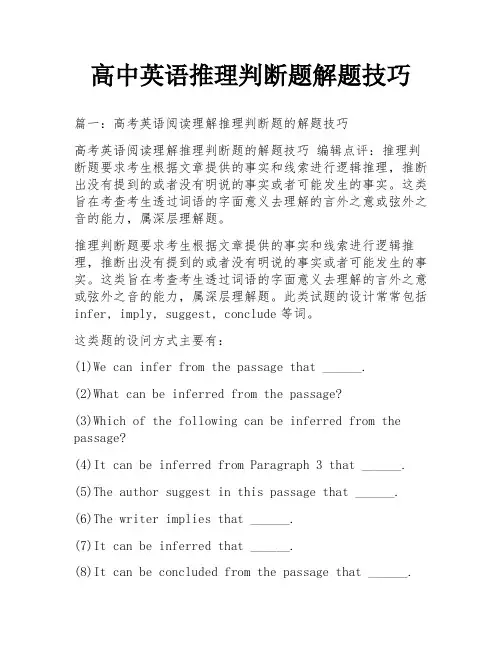
高中英语推理判断题解题技巧篇一:高考英语阅读理解推理判断题的解题技巧高考英语阅读理解推理判断题的解题技巧编辑点评:推理判断题要求考生根据文章提供的事实和线索进行逻辑推理,推断出没有提到的或者没有明说的事实或者可能发生的事实。
这类旨在考查考生透过词语的字面意义去理解的言外之意或弦外之音的能力,属深层理解题。
推理判断题要求考生根据文章提供的事实和线索进行逻辑推理,推断出没有提到的或者没有明说的事实或者可能发生的事实。
这类旨在考查考生透过词语的字面意义去理解的言外之意或弦外之音的能力,属深层理解题。
此类试题的设计常常包括infer, imply, suggest, conclude等词。
这类题的设问方式主要有:(1)We can infer from the passage that ______.(2)What can be inferred from the passage?(3)Which of the following can be inferred from the passage?(4)It can be inferred from Paragraph 3 that ______.(5)The author suggest in this passage that ______.(6)The writer implies that ______.(7)It can be inferred that ______.(8)It can be concluded from the passage that ______.(9)On the whole, we can conclude that ______.(10)From the text we can conclude that ______.(11)After reading the passage we may conclude that______.(12)What conclusion can be drawn from the passage?(13)The author is inclined to think that ______.(14)When the writer talks about..., what he really means is that______.(15)What's the writer's attitude towards...?(16)What's the author's feeling towards...?(17)In the writer's opinion...理解文段的隐含信息包括:推测或人物的观点、态度、意图、身份、情感,对或文段所涉及的人物、事件作出评价等,属于深层理解,是语言学习者必须具备的交际能力之一。
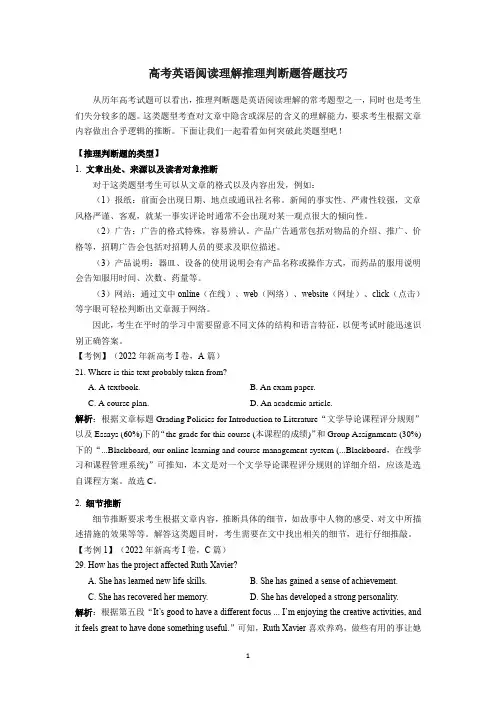
高考英语阅读理解推理判断题答题技巧从历年高考试题可以看出,推理判断题是英语阅读理解的常考题型之一,同时也是考生们失分较多的题。
这类题型考查对文章中隐含或深层的含义的理解能力,要求考生根据文章内容做出合乎逻辑的推断。
下面让我们一起看看如何突破此类题型吧!【推理判断题的类型】1. 文章出处、来源以及读者对象推断对于这类题型考生可以从文章的格式以及内容出发,例如:(1)报纸:前面会出现日期、地点或通讯社名称。
新闻的事实性、严肃性较强,文章风格严谨、客观,就某一事实评论时通常不会出现对某一观点很大的倾向性。
(2)广告:广告的格式特殊,容易辨认。
产品广告通常包括对物品的介绍、推广、价格等,招聘广告会包括对招聘人员的要求及职位描述。
(3)产品说明:器皿、设备的使用说明会有产品名称或操作方式,而药品的服用说明会告知服用时间、次数、药量等。
(3)网站:通过文中online(在线)、web(网络)、website(网址)、click(点击)等字眼可轻松判断出文章源于网络。
因此,考生在平时的学习中需要留意不同文体的结构和语言特征,以便考试时能迅速识别正确答案。
【考例】(2022年新高考I卷,A篇)21. Where is this text probably taken from?A. A textbook.B. An exam paper.C. A course plan.D. An academic article.解析:根据文章标题Grading Policies for Introduction to Literature“文学导论课程评分规则”以及Essays (60%)下的“the grade for this course (本课程的成绩)”和Group Assignments (30%)下的“...Blackboard, our online learning and course management system (...Blackboard,在线学习和课程管理系统)”可推知,本文是对一个文学导论课程评分规则的详细介绍,应该是选自课程方案。
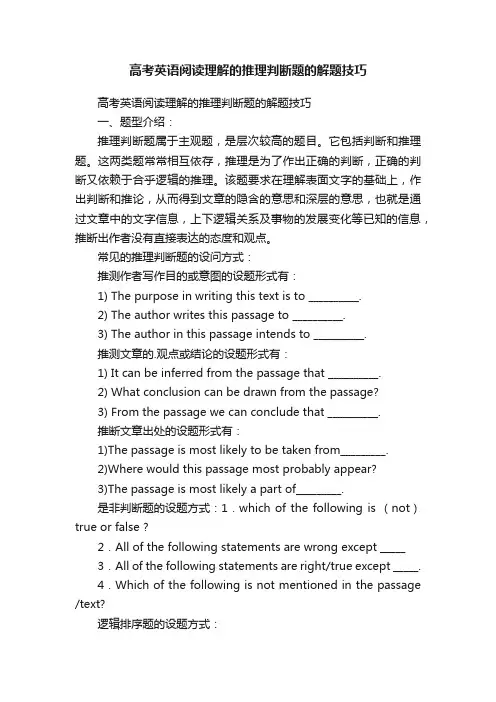
高考英语阅读理解的推理判断题的解题技巧高考英语阅读理解的推理判断题的解题技巧一、题型介绍:推理判断题属于主观题,是层次较高的题目。
它包括判断和推理题。
这两类题常常相互依存,推理是为了作出正确的判断,正确的判断又依赖于合乎逻辑的推理。
该题要求在理解表面文字的基础上,作出判断和推论,从而得到文章的隐含的意思和深层的意思,也就是通过文章中的文字信息,上下逻辑关系及事物的发展变化等已知的信息,推断出作者没有直接表达的态度和观点。
常见的推理判断题的设问方式:推测作者写作目的或意图的设题形式有:1) The purpose in writing this text is to __________.2) The author writes this passage to __________.3) The author in this passage intends to __________.推测文章的.观点或结论的设题形式有:1) It can be inferred from the passage that __________.2) What conclusion can be drawn from the passage?3) From the passage we can conclude that __________.推断文章出处的设题形式有:1)The passage is most likely to be taken from_________.2)Where would this passage most probably appear?3)The passage is most likely a part of_________.是非判断题的设题方式:1.which of the following is (not)true or false ?2.All of the following statements are wrong except _____3.All of the following statements are right/true except _____.4.Which of the following is not mentioned in the passage /text?逻辑排序题的设题方式:Which of the following describes one’s logic in doing sth ?Which of the following shows the correct order of what happened to …?Choose the right order of the following events in …二、推理判断题的解题方法:推理判断题不仅要求考生读懂文章中的每个句子的意思还要推理它们之间的关系,结合自己的生活常识和经验,再通过逻辑推理和判断,理解文章的言外之意,从而揭示文章的深层涵义。
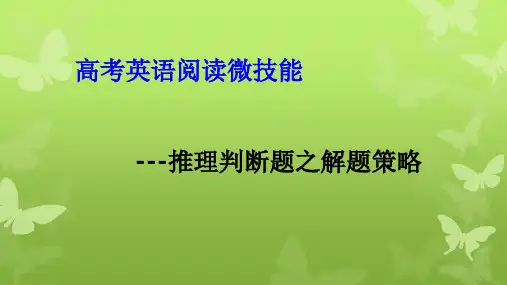
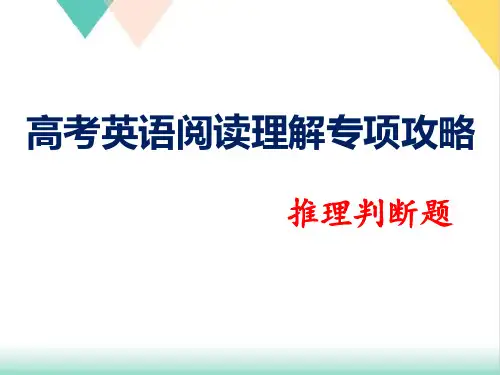
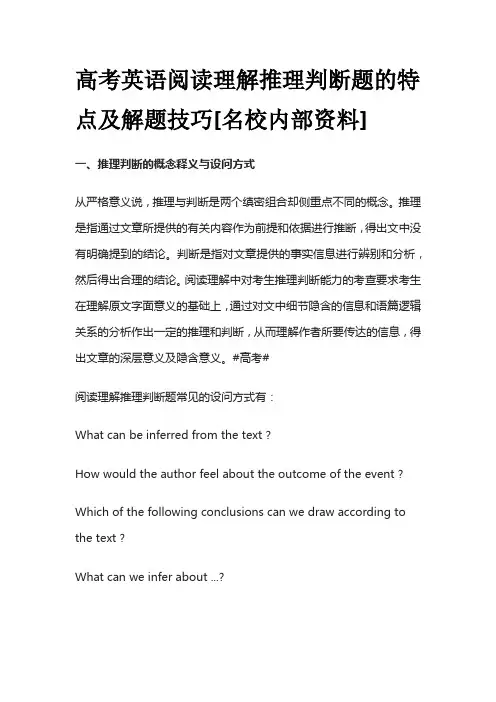
高考英语阅读理解推理判断题的特点及解题技巧[名校内部资料]一、推理判断的概念释义与设问方式从严格意义说,推理与判断是两个缜密组合却侧重点不同的概念。
推理是指通过文章所提供的有关内容作为前提和依据进行推断,得出文中没有明确提到的结论。
判断是指对文章提供的事实信息进行辨别和分析,然后得出合理的结论。
阅读理解中对考生推理判断能力的考查要求考生在理解原文字面意义的基础上,通过对文中细节隐含的信息和语篇逻辑关系的分析作出一定的推理和判断,从而理解作者所要传达的信息,得出文章的深层意义及隐含意义。
#高考#阅读理解推理判断题常见的设问方式有:What can be inferred from the text ?How would the author feel about the outcome of the event ?Which of the following conclusions can we draw according to the text ?What can we infer about ...?What can we know about the ... from the first paragraph ? What can we infer from the last paragraph ?What is the purpose of the last part of the text ?What is the author's purpose in writing the text ?What is the author's attitude to / toward the ...?Where might this passage be taken from ?What does the text imply ?Where can the text be found ?Where is the passage most likely to be taken from ?Where would this passage most probably appear ?二、推理判断题的细分题型特点及其解题技巧高考英语阅读理解推理判断题,根据考查的深层次内容,又可以再细分为“隐含意义推断题,观点态度推断题,写作意图推断题,文章出处或写作类型推断题和篇章结构推断题”5种小类型。
高考英语阅读理解推理判断题解题技巧高考英语阅读理解推理推断题解题技巧篇1推理推断属于高层次阅读理解,在解答时应留意以下几点:1.把握常见的提问形式常用infer, imply,suggest, conclude, learn, intend, mean, describe, purpose 等词提问,或提问中含有表示推想的情态动词,如:can, could, might, would 等何其他表示可能性的副词或词组,如probably, most likely 等。
2. 解题思路做题时肯定要从整体上把握语篇内容,在语篇的外表意义与隐含意义、已知信息与未知信息间架起桥梁,透过字里行间,去体会的“弦外音〞.在阅读是要抓住文章的主题和详情,分析文章结构,依据上下文内在联系,挖掘文章的深沉含义。
首先在进行推理时,要认真阅读短文,千万不行脱离原文而凭个人的看法,主观臆断。
其次对于暗含在文章中的人物的行为动机。
事件的因果关系及未言明的倾向、意图、看法、观点等要进行合乎规律的推断。
推理分析,进一步增添理解能力,抓住材料实质性的东西。
再次,在解答推理问题时,应清晰应清晰所要解答的问题是针对某个详情进行推断,还是针对主题思、的意图进行推断。
针对详情的推断可运用略读的方法,快速在阅读材料中确定推理根据的位置或范围,然后在进行推理推断。
针对主题思想进行推断时,其解题的主要根据是文章的主题思想,然后再分析句子之间的规律关系,区分观点与例证(opinion and fact)、缘由与结果(cause and effect),主观点与次观点(main idea and supporting idea)3.推理题的解题方法(1)抓住特定的信息进行逆向或正向推理做此类试题时,要擅长某一段话中的'关键信息,即某些关键词或短语去分析、推理推断,利用逆向思维或正向推理,从而推断出这句话所隐含的深层含义。
(2)整合全文(段)信息进行推断做推理题时,有时需要在弄懂全文意思的基础上,整合与题目相关的有用信息,综合起来进行推理推断,确定最正确结论。
高考英语阅读理解推理判断题解题技巧阅读能力的考查不但要求理解具体事实细节,也要求理解抽象的含义,既要求理解字面意思,又要求理解其深层含义,包括作者的态度、观点、意图等;既要求理解文章中某句、某段的含义及全文的逻辑关系,又要求根据其含义及逻辑关系进行推理和判断。
推理判断属于高层次阅读理解,在解答时应注意以下几点:1.掌握常见的提问形式常用infer, imply, suggest, conclude, learn, intend, mean, describe, purpose等词提问,或提问中含有表示推测的情态动词,如:can, could, might, would等何其他表示可能性的副词或词组,如 probably, most likely 等。
2. 解题思路做题时一定要从整体上把握语篇内容,在语篇的表面意义与隐含意义、已知信息与未知信息间架起桥梁,透过字里行间,去体会作者的“弦外音”.在阅读是要抓住文章的主题和细节,分析文章结构,根据上下文内在联系,挖掘文章的深沉含义。
首先在进行推理时,要仔细阅读短文,千万不可脱离原文而凭个人的看法,主观臆断。
其次对于暗含在文章中的人物的行为动机。
事件的因果关系及作者未言明的倾向、意图、态度、观点等要进行合乎逻辑的推断。
推理分析,进一步增强理解能力,抓住材料实质性的东西。
再次,在解答推理问题时,应清楚所要解答的问题是针对某个细节进行判断,还是针对主题思、作者的意图进行判断。
针对细节的推断可运用略读的方法,迅速在阅读材料中确定推理依据的位置或范围,然后在进行推理判断。
针对主题思想进行判断时,其解题的主要依据是文章的主题思想,然后再分析句子之间的逻辑关系,区分观点与例证(opinion and fact )、原因与结果( cause and effect) ,主观点与次观点( main idea and supporting idea )3.推理题的解题方法(1)抓住特定的信息进行逆向或正向推理做此类试题时,要善于某一段话中的关键信息,即某些关键词或短语去分析、推理判断,利用逆向思维或正向推理,从而推断出这句话所隐含的深层含义。
高考英语阅读理解推理判断题的解题这类题属于主观题,是层次较高的设题。
它包括判断和推理题。
这两类题常常相互依存,推理是为了得出正确的判断,正确的判断又依赖于合乎逻辑的推理。
推理题要求在理解原文表面文字信息的基础上,做出一定判断和推论,从而得到文章的隐含意义和深层意义。
推理题所涉及的内容可能是文中某一句话,也可是某几句话,但做题的指导思想都是以文字信息为依据,既不能做出在原文中找不到文字根据的推理,也不能根据表面文字信息做多步推理。
所以,推理题的答案只能是根据原文表面文字信息一步推出的答案:即对原文某一句话或某几句话所作的同义改写(paraphrase)或综合。
常见的题干有:1) It can be inferred from the text that.2) We can conclude that.3) When the writer talks about..., what he really means is that.4) Which of the following can be inferred from the passage?判断题考查学生在理解文章的基础上,对不同观点进行评价和判断的能力。
推理题考查学生由文章的字面信息推出未知信息或隐含信息的能力。
1) 判断有据, 推论有理, 忠实原文。
切忌用自己的观点代替作者的本意。
2) 全面分析所有相关信息,切忌片面思考,得出片面结论。
3) 善于揣摩作者思路,尽可能与作者的思路吻合。
4)不可直接选取文中的原句。
例1: AnnealingAnnealing is a way of making metal softer by heating it and then letting it cool very slowly.If metal is heated and then cooled very quickly, for example by dipping (浸) it in water, it will bevery hard but also very brittle-that is, it will break easily. Metal that has been annealed is soft butdoes not break as easily. It is possible to make metal as hard or as soft as it is wished, by annealingit. The metal is heated, and allowed to cool slowly for a certain length of time. The longer theheated metal takes to cool slowly, the softer it becomes. Annealing can also be used on othermaterial, such as glass.(1990NMET)Why do people put hot metal in waterA. To make it hard.B. To make it soft.C. To make it cool.D. To make it brittle.[分析]答案为A,此题属推断归纳题。